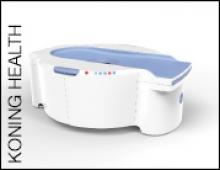Koning 3D Breast CT
Koning announces that its Koning Breast CT is undergoing a breast cancer screening trial for the imaging device, which was US Food and Drug Administration (FDA) PMA approved for commercial, diagnostic use in 2017. The Koning Breast CT is a no-compression, isotropic, 3D imaging device, the only such non-compression device available, and is in use globally. Koning reports that the device not only provides for a better patient experience because of the comfort of use compared with other types of screening modalities including mammography but it also provides exceptional spatial resolution, allowing for better evaluation and visualization of the breast tissue. Mammography misses 30% of cancers, Koning points out, and they say that their device addresses this problem while still using low-dose radiation levels.
Koning expects to submit trial data for their ongoing screening study to the FDA in Q1 2022.
For more information, visit https://www.koninghealth.com/en/
New STI treatment resources
There were 1.8 million cases of chlamydia among men and women reported in 2019, making it the most common sexually transmitted infection. Screening for chlamydia is targeted to adolescent and young adult women, as they are disproportionately affected by the infection—with 3,728 cases per 100,000 women, compared with 553 cases per 100,000 population. Undiagnosed and untreated chlamydia can lead to pelvic inflammatory disease (in about 20% of women) and, in pregnant women, can result in early labor and can even affect the baby (leading to conjunctivitis or pneumonia).
Healthcare Effectiveness and Data Information Set (HEDIS) measures are performance improvement measures used for health plans to track various dimensions of care. In 2019, the HEDIS measure for chlamydia screening showed that commercial and Medicaid health plans had an average 52% screening rate among sexually active 16- to 24-year-old women. In an effort to increase screening rates among young women, the Centers for Disease Control and Prevention has implemented opt-out, or universal screening, for chlamydia. In order to aid clinicians in implementing this opt-out screening into their practices, the American Sexual Health Association and the National Chlamydia Coalition created resources that offer guidance, including using normalizing language with patients to explain the screening strategy. Providers can access these resources online (http://chlamydiacoalition.org/opt-out-screening/). Videos are offered and include case examples of how to speak with patients about universal screening, and printable documents are included that expand on ways that practices can improve screening rates.
For more information, visit http://chlamydiacoalition.org/opt-out-screening/.
Koning 3D Breast CT
Koning announces that its Koning Breast CT is undergoing a breast cancer screening trial for the imaging device, which was US Food and Drug Administration (FDA) PMA approved for commercial, diagnostic use in 2017. The Koning Breast CT is a no-compression, isotropic, 3D imaging device, the only such non-compression device available, and is in use globally. Koning reports that the device not only provides for a better patient experience because of the comfort of use compared with other types of screening modalities including mammography but it also provides exceptional spatial resolution, allowing for better evaluation and visualization of the breast tissue. Mammography misses 30% of cancers, Koning points out, and they say that their device addresses this problem while still using low-dose radiation levels.
Koning expects to submit trial data for their ongoing screening study to the FDA in Q1 2022.
For more information, visit https://www.koninghealth.com/en/
New STI treatment resources
There were 1.8 million cases of chlamydia among men and women reported in 2019, making it the most common sexually transmitted infection. Screening for chlamydia is targeted to adolescent and young adult women, as they are disproportionately affected by the infection—with 3,728 cases per 100,000 women, compared with 553 cases per 100,000 population. Undiagnosed and untreated chlamydia can lead to pelvic inflammatory disease (in about 20% of women) and, in pregnant women, can result in early labor and can even affect the baby (leading to conjunctivitis or pneumonia).
Healthcare Effectiveness and Data Information Set (HEDIS) measures are performance improvement measures used for health plans to track various dimensions of care. In 2019, the HEDIS measure for chlamydia screening showed that commercial and Medicaid health plans had an average 52% screening rate among sexually active 16- to 24-year-old women. In an effort to increase screening rates among young women, the Centers for Disease Control and Prevention has implemented opt-out, or universal screening, for chlamydia. In order to aid clinicians in implementing this opt-out screening into their practices, the American Sexual Health Association and the National Chlamydia Coalition created resources that offer guidance, including using normalizing language with patients to explain the screening strategy. Providers can access these resources online (http://chlamydiacoalition.org/opt-out-screening/). Videos are offered and include case examples of how to speak with patients about universal screening, and printable documents are included that expand on ways that practices can improve screening rates.
For more information, visit http://chlamydiacoalition.org/opt-out-screening/.
Koning 3D Breast CT
Koning announces that its Koning Breast CT is undergoing a breast cancer screening trial for the imaging device, which was US Food and Drug Administration (FDA) PMA approved for commercial, diagnostic use in 2017. The Koning Breast CT is a no-compression, isotropic, 3D imaging device, the only such non-compression device available, and is in use globally. Koning reports that the device not only provides for a better patient experience because of the comfort of use compared with other types of screening modalities including mammography but it also provides exceptional spatial resolution, allowing for better evaluation and visualization of the breast tissue. Mammography misses 30% of cancers, Koning points out, and they say that their device addresses this problem while still using low-dose radiation levels.
Koning expects to submit trial data for their ongoing screening study to the FDA in Q1 2022.
For more information, visit https://www.koninghealth.com/en/
New STI treatment resources
There were 1.8 million cases of chlamydia among men and women reported in 2019, making it the most common sexually transmitted infection. Screening for chlamydia is targeted to adolescent and young adult women, as they are disproportionately affected by the infection—with 3,728 cases per 100,000 women, compared with 553 cases per 100,000 population. Undiagnosed and untreated chlamydia can lead to pelvic inflammatory disease (in about 20% of women) and, in pregnant women, can result in early labor and can even affect the baby (leading to conjunctivitis or pneumonia).
Healthcare Effectiveness and Data Information Set (HEDIS) measures are performance improvement measures used for health plans to track various dimensions of care. In 2019, the HEDIS measure for chlamydia screening showed that commercial and Medicaid health plans had an average 52% screening rate among sexually active 16- to 24-year-old women. In an effort to increase screening rates among young women, the Centers for Disease Control and Prevention has implemented opt-out, or universal screening, for chlamydia. In order to aid clinicians in implementing this opt-out screening into their practices, the American Sexual Health Association and the National Chlamydia Coalition created resources that offer guidance, including using normalizing language with patients to explain the screening strategy. Providers can access these resources online (http://chlamydiacoalition.org/opt-out-screening/). Videos are offered and include case examples of how to speak with patients about universal screening, and printable documents are included that expand on ways that practices can improve screening rates.
For more information, visit http://chlamydiacoalition.org/opt-out-screening/.
Content Gating
No Gating (article Unlocked/Free)
Consolidated Pubs: Do Not Show Source Publication Logo
Conference Recap Checkbox
Not Conference Recap
Display the Slideshow in this Article
Disable Inline Native ads

